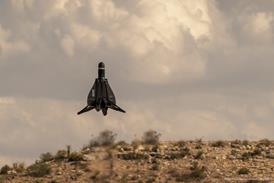The history of aerospace endeavour reveals several predictions that the end is nigh for manned military aircraft. Such prophecies have been wide of the mark, but now we are witnessing an explosion in the use of unmanned air vehicles (UAVs). While no-one is suggesting UAVs will replace manned aircraft, they will change the shape of military force structures.
Soothsayers foresee UAVs ranging from micro-machines capable of reconnaissance inside buildings to aircraft larger than the Northrop Grumman RQ-4A Global Hawk.
Unmanned combat air vehicles (UCAV) will do much of the dirty work, missions considered too likely to result in casualties - roles such as the destruction, as well as suppression, of enemy air defences and low-level strike missions in place of manned aircraft being forced to go to medium altitudes.
The ever-innovative Swedes are studying a network warfare system with UAVs supporting the frontline platforms and controlled by desktop computer and mouse. Although the idea perhaps seems far-fetched, it is rather appealing. Consider a reconnaissance UAV providing targeting for manned Saab Gripens, which in turn would leave behind a battle damage assessment UAV able to call in further strikes if necessary.
The US Army has demonstrated the functionality of controlling a UAV from a manned vehicle, with an Israel Aircraft Industries/TRW Hunter operating in tandem with a Boeing AH-64D Apache Longbow. The helicopter crew was able to use the UAV to reconnoitre the ground ahead of the Apache. In later trials the pair will link to select targets and hand-off information to armed helicopters.
With today's focus on eliminating collateral damage and civilian casualties, issues of UCAV survival, autonomy, and airworthiness need to be thought through. It may well be that the weapon system can distinguish targets without fault and launch weapons with unerring accuracy, but this is of little consequence if the platform goes astray en route, causing more damage than when dropping a bomb.
Sensors will need to be sophisticated, possibly more so than for manned machines, and there will likely be a need to datalink information back to a ground station to provide a man-in-the-loop solution to ease the inevitable concerns that a machine is taking the decision to launch a weapon. Providing a high level of sophistication and the necessary bandwidth for real-time targeting video will be expensive to procure.
Cost questions - important in all military procurements - become even more crucial with UCAVs, as they are likely to be stored until needed in wartime. Try telling a politician you're going to spend billions of dollars on new defence equipment, lock it in a shed and hope that it works when the time comes. But there is the appeal of reduced aircrew and training costs. The US Senate Armed Services Committee predicts that in the future, 33% of US combat aircraft will be unmanned, reducing aircrew training costs and perhaps easing the pilot shortages almost all air forces are suffering. Synthetic training should shrink costs further.
All these plans could sound like flights of fantasy, but programmes are moving ahead which will see UAVs and UCAVs play a major role from the later years of this decade.
As well as Sweden's developments, Boeing is poised to roll out the first of two X-45 UCAV demonstrators. At the end of the test programme the X-45 pair will autonomously detect, identify and strike a surface-to-air missile site, while evading enemy air defences.
So while the pilot's place in the cockpit is assured, there is acceptance that the world is moving towards greater use of UAVs as a support to manned platforms. Emerging technologies will allow widespread use of autonomous UCAVs that will keep pilots out of harm's way.
Ten years ago this was all the realms of science fiction, and today's plans barely scratch the surface of what will be possible as technology develops. Maybe predictions of the demise of manned aircraft are wide of the mark, but UAVs are going to change the shape of military aerospace.
Source: Flight International























